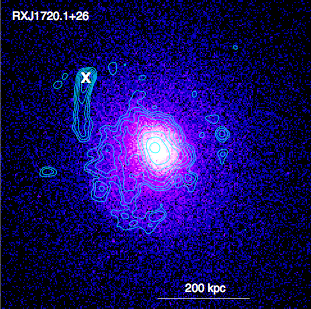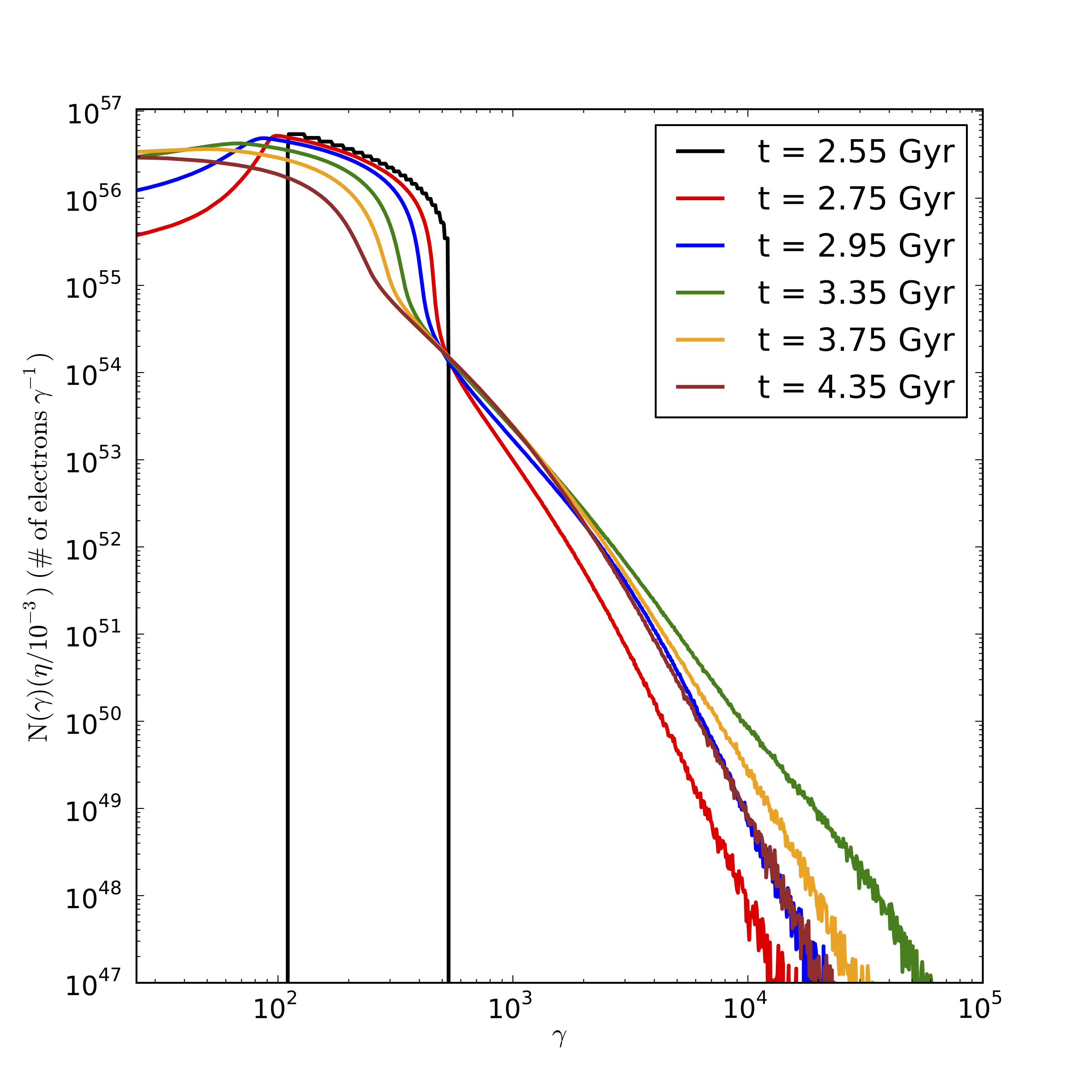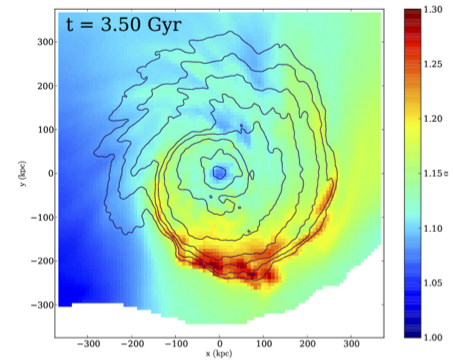Cosmic-Ray Electrons and Radio Emission in Merging Galaxy Clusters
simulations of relativistic electrons interacting with the ICM
Overview
A number of galaxy clusters contain diffuse, steep-spectrum radio emission. The most obvious of these are large, extended sources (R ~ 1 Mpc) that are often found in merging clusters, known as “radio halos”. There is a second class of these features, found in the cool cores of more relaxed galaxy clusters (R ~ 100-200 kpc), known as “radio minihalos.” To be observed at frequencies of 100s of MHz to 1 GHz, the radio emission must be produced by relativistic electrons with energies \(\gamma \sim 10^3 - 10^4\). Since the time for cosmic-ray electrons (CRe) to diffuse across the cluster is much longer than their radiative loss time at these energies, the electrons must either be reaccelerated by some process or continuously injected in situ.


Reacceleration Models for Mini-Halos
CRe with energies \(\gamma \sim 10^2\) may build up in the cluster volume due to acceleration by AGN and shocks and production via hadronic processes. These electrons may then be reaccelerated by MHD turbulence driven by cluster mergers. Relativistic particle reacceleration provides a natural explanation for the steepening of the spectrum at high (~1 GHz) frequencies seen in many halos and minihalos, due to the competition of reacceleration and radiative losses. In a cool core cluster, interactions with subclusters produce sloshing of the gas, which is observed in the X-ray band as spiral-shaped cold fronts. Mazzotta & Giacintucci 2008 discovered a correlation between sloshing cold fronts and radio minihalo emission in two galaxy clusters, and other examples have been found since.

In line with this evidence, in (ZuHone et al., 2013) we performed a MHD simulation of gas sloshing in a cool-core cluster and included the The sloshing produces MHD turbulence with \(\delta{v}\) ~ 200 km/s onlength scales of ~10 kpc, which we showed is capable of accelerating relativistic CRe up to the energies required for producing a minihalo. The spatial distribution of the radio surface brightness and its spectrum are consistent with observed minihalos. In particular, the minihalo emission is bounded by the sloshing cold fronts, exhibiting very sharp drops across cold front surfaces (Figure 1). Secondly, the minihalo emission is steep-spectrum, due to the trade-off between reacceleration and radiative losses on the CRe at high energies (Figure 2, left). Also, the minihalo is produced on a very short timescale (< 1 Gyr) and decays afterward (Figure 2, right). This is in line with the fact that not all cool-core clusters possess minihalos.
Hadronic Models for Mini-Halos
In a subsequent work (ZuHone et al., 2015), we studied an alternative hypothesis for the origin of radio mini-halos: the interplay of sloshing and the injection of relativistic CRe via hadronic interactions, which arise from collisions between cosmic-ray protons (CRp) and thermal protons in the ICM that produce secondary CRe. In this scenario, the confinement of the radio emission to the volume bounded by the cold fronts is explained by the amplification of the magnetic field below the cold fronts (Keshet & Loeb 2010). This rapid field amplification is also held in this view to be responsible for the steepening of the CRe and radio spectra seen in minihalo (and radio halo) sources (Keshet 2010).


We employed a simplified model where the hadronically generated CRe spectrum was allowed to deviate from a steady-state model due to rapid magnetic field amplification. In our simulation, diffuse radio emission with the power and spatial extent typical of mini-halos was produced. However, this emission had very different properties than that produced in our previous simulations using CRe reacceleration. Firstly, the emission was more extended, exhibiting only shallow drops across cold front surfaces (Figure 3). Secondly, we found that the spectral steepening produced by rapid magnetic field amplification was marginal, resulting in a steepening of the radio spectral index \(\Delta\alpha\) < 0.2 (Figure 4), which is inconsistent with a number of minihalos with steeper spectra.
Redistribution of Cosmic Rays from Active Galactic Nuclei
Regardless of the model for the production of radio mini-halos (whether reacceleration or hadronic), the origin of the CRe to be reaccelerated or the CRp to produce the secondaries must still be explained. The most natural explanation for the prevalence of relativistic particles in the ICM is that they are injected by AGN. In (ZuHone et al., 2021), we placed a black hole particle with an AGN jet into one of our sloshing simulations, varying the jet axis for different simulations, to determine how sloshing redistributes the cosmic-ray material from the jet (in this work, modeled by a simple tracer field that is advected along with the thermal gas). We found that the bulk motions and the turbulence from sloshing efficiently redistribute the jet material throughout the cluster core. Also, some of this material rises to a significant height and is then stretched by the sloshing motions, producing linear features in the projected CR distribution with magnetic fields aligned along the feature. We also explored a scenario where a bubble was placed at a large distance and was then redistributed, with similar results. From these results, we hypothesized that such long and thin features could be an explanation for some radio relics, assuming a shock from a later merger passes over them. Examples of these simulations are shown in (Figure 5).
Jets along x-axis:
Jets along y-axis:
Jets along z-axis:
We followed up with a similar set of simulations in (ZuHone et al., 2021), only this time improving the physical description of the cosmic rays. In this work, we treated the cosmic rays as a separate fluid with \(\Gamma\) = 4/3, and explored the effects of Alfvén cooling and spatial diffusion. The result was that the density of cosmic rays in the radio relic-like features was decreased. More study is needed to determine the likelihood that radio relics can be formed in this way. More recently (Domı́nguez-Fernández P. et al., 2024) expanded the parameter space of mergers producing sloshing motions and AGN jets over (ZuHone et al., 2021), to determine if the same subcluster that redistributed the CRs in the first place by setting off the sloshing motions could also produce radio relics by running over the CRs on a second or third pass. We found that such a scenario is very unlikely; in most cases the shocks from the second core passage are too weak to efficiently reaccelerate the CRs, so a separate merger is most likely needed.